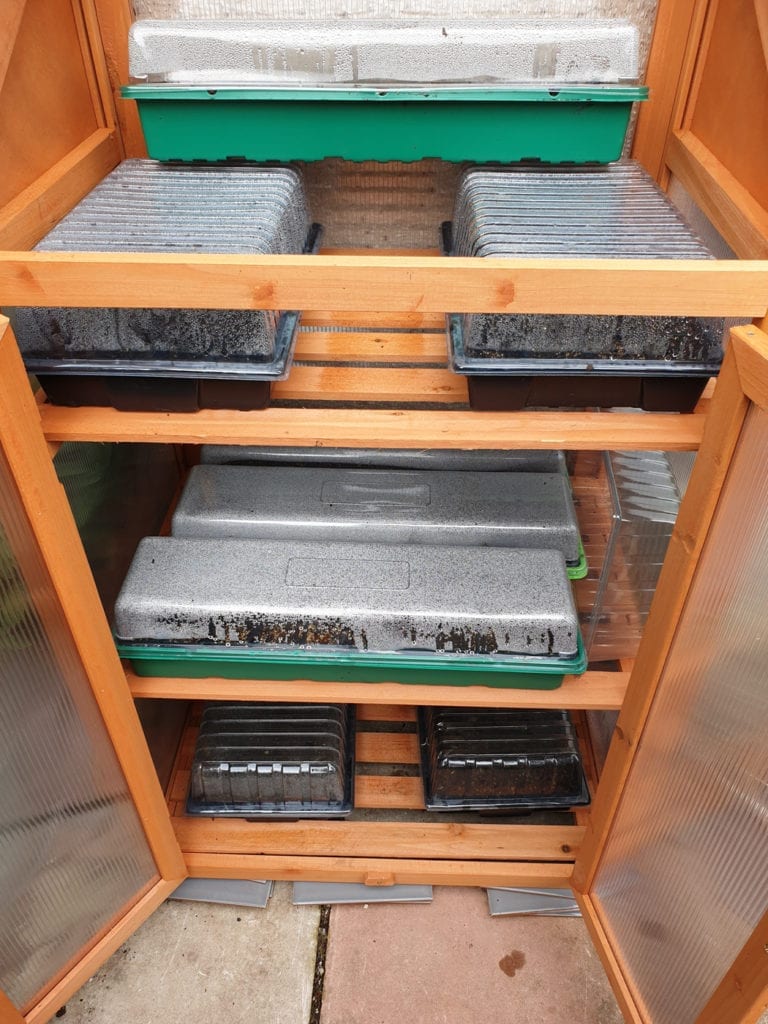The weather so far this Spring has been distinctly odd, oscillating from “taps aff” to “taps an again!” as clear, blue skies became semi-apocalyptic, sleet-filled spectacles in mere moments.
Over the last week it has settled down a little. Bulbs are springing up. Grass is growing. Has the risk of frost passed? No, but the odds are getting longer and I’m prepared to take a gamble. Go me.
So it was that last weekend I tentatively sowed sweetcorn, squash, pea, tomato, courgette, celeriac and globe artichoke seeds into module trays and placed them into a new wooden grow-house in the garden.
It means I can tend to around 200 seedlings from the back door instead of on the plot, saving a 3-mile round trip.
Some seeds, such as sweetcorn, pea and beans, are basically dried versions of what you eat.
Others are much harder to identify. Cabbage seeds look more like poppy seeds, almost impossibly tiny considering what they will grow into and hard to sow well because they disappear as soon as they hit soil.
Carrot seeds look like cumin (turns out they are related!). It’s amazing to think that whatever colour or shape they are, all seeds hold within them the information needed to become a fully grown, food-producing plant. They just need a bit of help.
I much prefer to sow directly into the earth because it is far less work than transplanting seedlings.
Direct sowing is only possible once the ground temperature rises though, so starting off under cover makes sense except for the most hardy or quick growing plants. At the other end of the spectrum are some particularly delicate plants which insist on being mollycoddled as they grow.
Yes, I’m talking about you curcubits.
I’ve made several visits to the plot since my last entry. It feels great to be there, genuinely disconnected from the real world for a time. Apart from the pub, where else gives you that?
It’s a liminal space!
Stepping through the low wooden gate I become absorbed and recharged by the ebb and flow of plot life. Watching, planning, making, fixing, doing. Last week I planted potatoes and two new apple trees as well as sowing spinach, salad and broad beans.
It’s an actively immersive experience right up to the reflective cup of tea at the end. It’s not easy though. It’s hard, physical work and unexpected challenges crop up all the time. But they are all, in an odd way, welcome. For what is life without
challenge?

The growing house with seedlings. Picture: Joe Hind
For example, the challenge of deterring creatures that want to eat your food. I put netting up last year to stop butterflies laying eggs in the brassica but we still found plenty of small, silvery balls in a recent gathering of kale. Sure enough, these were eggs, ready to hatch into very hungry caterpillars who would have all the food they could eat right in front of them thanks to careful planning by mum.
It’s quite clever really.
Growing without chemicals, as we try to do, means you have to accept that you will inevitably eat the odd little creature or its eggs. I perhaps shouldn’t have said those exact words to my daughters.
Visiting the plot this year has been tinged with sadness. My allotment neighbour died before his time last Autumn. Parts of his plot remain unnervingly as he left them.
The fronds of his asparagus plants still waft in the breeze. His large rowan tree, which shades a corner of my plot (compost corner) is still full of birds that he could identify by species, extending far beyond my “big squawky one” level of knowledge.
I knew him for less than a year, but it was my first year of having an allotment and his uncritical presence was reassuring. I also appreciated his growing style which I would characterise as “faff free”, whereby anything that remotely constituted faff was summarily dismissed. I will gladly carry that philosophy forward in his memory.
Having re-washed the “eggy” kale I tried out a recipe which I wanted to share. It’s not my invention but it is simple and extremely tasty.
• Clean hands thoroughly (you’ll need them later)
• Use scissors to cut all thick stalks off 250g kale and chop into medium-sized pieces into large bowl.
• Pour over approx. 30ml extra virgin olive oil and the juice of a lemon (or lime).
• Add two pinches of salt
• Massage kale (yes really, go for deep-tissue style) for 5 or so minutes until it changes colour to dark green and reduces in volume by about a third.
• Add 50g of grated parmesan (other hard cheeses will work) and stir well.
That’s it! It may well become your favourite way to eat kale. Even my kids loved it once I managed to persuade them that all the little creatures and their eggs had been removed.
I doubt this was entirely true.
Keeping the Plot: A journal of growing and cooking Scottish produce - Early March 2019